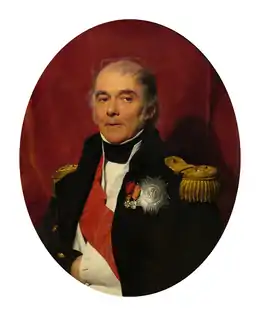Henri Gatien Bertrand
Henri-Gatien, comte Bertrand (28 March 1773 – 31 January 1844), was a French general.
Henri-Gatien, comte Bertrand | |
|---|---|
 General Henri-Gatien Bertrand | |
| Born | 28 March 1773 Châteauroux, France |
| Died | 31 January 1844 (aged 70) Châteauroux, France |
| Allegiance | |
| Years of service | 1793-1816 |
| Rank | Général de Division |
| Battles/wars | Battle of the Pyramids Battle of Austerlitz Battle of Jena–Auerstedt Battle of Eylau Battle of Wagram Battle of Aspern-Essling |
| Awards | Name engraved on the Arc de Triomphe in Paris
Grand Eagle of the Legion of Honour Count of the First French Empire |
| Other work | Grand marshal of the palace Commander of École Polytechnique |
Life
He was born at Châteauroux, Indre as a member of a well-to-do bourgeois family.[1]
At the outbreak of the French Revolution, he had just finished his studies at the Prytanée National Militaire, and he entered the army as a volunteer. During the expedition to Egypt, Napoleon named him colonel (1798), then brigadier-general, and after the Battle of Austerlitz his aide-de-camp. His life was henceforth closely bound up with that of Napoleon, who had the fullest confidence in him, honoring him in 1808 with the title of count and at the end of 1813, with the title of Grand Marshal of the Palace.
In 1808 Bertrand married Fanny, the daughter of general Arthur Dillon and through her mother a cousin of the Empress Joséphine. They had six children, with one being born on Elba and another on Saint Helena.
It was Bertrand who in 1809 directed the building of the bridges by which the French army crossed the Danube at Wagram. In 1811, the Emperor appointed Bertrand governor of the Illyrian Provinces and during the German campaign of 1813, he commanded IV Corps which he led in the battles of Großbeeren, Dennewitz and Leipzig.[1]
In 1813, after the Battle of Leipzig, it was due to his initiative that the French army was not totally destroyed. He accompanied the Emperor to Elba in 1814, returned with him in 1815, held a command in the Waterloo campaign, and then, after the defeat, accompanied Napoleon to St Helena. Condemned to death in 1816, he did not return to France until after Napoleon's death, and then Louis XVIII granted him amnesty allowing him to retain his rank. Bertrand was elected deputy in 1830 but defeated in 1834. In 1840 he was chosen to accompany the Prince of Joinville to St. Helena to retrieve and bring Napoleon's remains to France, in what became known as the retour des cendres.[1]
During his exile on St Helena he compiled Napoléon's confidences in a book entitled "Les cahiers de Sainte Hélène". The manuscript was codified and later decodified and commented by Paul Fleuriot de Langle. According to historians, this document is more accurate than Las Cases' "Memorial de Sainte Hélène" which reached a much larger amount of readers in the 19 century as it was designed for propangadistic purposes.
He died at Châteauroux on 31 January 1844 and was buried in Les Invalides. [1] Alexandre Dumas mentions Bertrand in the earlier pages of his well-known novel The Count of Monte Cristo. He is also mentioned in Book II Chapter 1 of Les Misérables by Victor Hugo.
References
- Attribution
 This article incorporates text from a publication now in the public domain: Chisholm, Hugh, ed. (1911). "Bertrand, Henri Gratien". Encyclopædia Britannica. 3 (11th ed.). Cambridge University Press.
This article incorporates text from a publication now in the public domain: Chisholm, Hugh, ed. (1911). "Bertrand, Henri Gratien". Encyclopædia Britannica. 3 (11th ed.). Cambridge University Press.